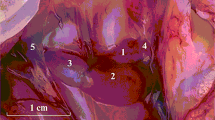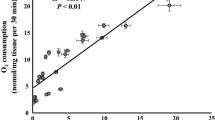Abstract
Nineteen species of littoral marine invertebrates, representing Porifera, Cnidaria, Ctenophora, Brachiopoda, Mollusca, and Arthropoda, were studied with respect to the ability of tissue extracts to catalyze the lactate and succinate dehydrogenase reactions in both directions. Pyruvate reductase (PR) activity varied tremendously with species, from 0.014 μmole/min/g of tissue in the etenophore Mnemiopsis leidyi to 145 μ-moles/min in leg muscle of the horseshoe crab Limulus polyphemus, a 10,000-fold range. Lactate dehydrogenase (LD) activity varied from 0.010 in the ctenophore to 2.91 in the squid Loligo pealei, a 300-fold range. The ratio PR/LD, indicating the probability of lactic acid production, was 1,968 in muscle of the flounder, the only vertebrate studied. It was very much lower in all invertebrates; in a brachiopod, Terebratulina septentrionalis, the ratio was only 0.68. Fumarate reductase (FR) and succinate dehydrogenase (SD) activities varied less widely. The extremes of the ratio FR/SD, indicating the probability of succinic acid production, were 0.24 in the clam Mercenaria mercenaria, and 7.6 in the oyster Crassostrea virginica. PR/LD appears related to the capacity for vigorous muscular activity, sustaining rapid movement of larger animals, and FR/SD appears related to tolerance of temporary anaerobiosis, such as found in sessile animals that close their valves tightly on exposure to air during low tide.
Similar content being viewed by others
Literature cited
Arrigoni, O. and T. P. Singer: Limitations of the phenazine methosulphate assay for succinic and related dehydrogenases. Nature, Lond. 193, 1256–1258 (1962).
Awapara, J. and J. W. Simpson: Comparative physiology: metabolism. A. Rev. Physiol. 29, 87–112 (1967).
Barron, E. S. G., W. P. Sights and V. Wilder: The carbohydrate metabolism of heart slices. Arch. exp. Path. u. Pharmak. 219, 338–348 (1953).
Bayne, R. A., L. Hendricks, R. Beckerdite and R. Harkema: Comparisons of lactate dehydrogenase in several trematodes and a host tissue. Comp. Biochem. Physiol. 24, 275–278 (1968).
Bennett, R. Jr. and H. I. Nakada: Comparative carbohydrate metabolism of marine mollusks. 1. The intermediary metabolism of Mytilus californianus and Haliotis rufescens. Comp. Biochem. Physiol. 24, 787–797 (1968).
Brand, T. von: Anaerobiosis in invertebrates, 328 pp. Normandy, Missouri: Biodynamica 1946.
Chapheau, M.: Recherches sur le métabolisme cellulaire de quelques Invertébrés marins. C. r. Séanc. Soc. Biol. 110, 970–972 (1932).
Hammen, C. S.: Metabolism of the oyster, Crassostrea virginica. Am. Zool. 9, 309–318 (1969).
— and S. C. Lum: Fumarate reductase and succinate dehydrogenase activities in bivalve mollusks and brachiopods. Comp. Biochem. Physiol. 19, 775–781 (1966).
Krishnaswamy, S., J. E. G. Raymont and J. Tundisi: Sucinic dehydrogenase activity in marine animals. Int. Revue ges. Hydrobiol. 52, 447–451 (1967).
Ladanyi, P. et C. Leray: Etude comparative biochimique et histochimique des métabolismes glucidiques et respiratoires des muscles de quelques mollusques Méditerranéens. Mar. Biol. 1, 210–215 (1968).
Latner, A. L. and A. W. Skillen: Isoenzymes in biology and medicine, 289 pp. New York: Academic Press 1968.
Long, G. L. and N. O. Kaplan: D-lactate specific pyridine nucleotide lactate dehydrogenase in animals. Science, N.Y. 162, 685–686 (1968).
Massey, V. and T. P. Singer: Studies on succinic dehydrogenase. 3. The fumaric reductase activity of succinic dehydrogenase. J. biol. Chem. 228, 263–274 (1957).
Raymont, J. E. G., S. Krishnaswamy and J. Tundisi: Biochemical studies on marine zooplankton. 4. Investigations on succinic dehydrogenase activity in zooplankton with special reference to Neomysis integer. J. Cons. perm. int. Explor. Mer 31, 164–169 (1967).
Roberts, N. R., R. R. Coelho, O. H. Lowry and E. J. Crawford: Enzyme activities of giant squid axoplasm and axon sheath. J. Neurochem. 3, 109–115 (1958).
Robin, Y. et N. van Thoai: Métabolisme des dérivés guanidyles. 10. Métabolisme de l'octopine: son rôle biologique. Biochim. biophys. Acta 52, 233–240 (1961).
Schwartz, M. K. and O. Bodansky: Lactic dehydrogenase. (clinical aspects). In: Methods in enzymology, Vol. 9, pp 294–302. Ed. by W. A. Wood. New York: Academic Press 1966.
Simpson, J. W. and J. Awapara: The pathway of glucose degradation in some invertebrates. Comp. Biochem. Physiol. 18, 537–548 (1966).
Singer, T. P.: Comparative biochemistry of succinate dehydrogenase: forms and functions. In: Oxidases and related redox systems, Vol. 1, pp 448–471. Ed. by T. E. King, H. S. Mason and M. Morrison. New York: John Wiley 1965.
Wilson, A. C., R. D. Cahn and N. O. Kaplan: Functions of the two forms of lactic dehydrogenase in the breast muscle of birds. Nature, Lond. 197, 331–334 (1963).
Author information
Authors and Affiliations
Additional information
Communicated by G.L. Voss, Miami
Rights and permissions
About this article
Cite this article
Hammen, C.S. Lactate and succinate oxidoreductases in marine invertebrates. Mar. Biol. 4, 233–238 (1969). https://doi.org/10.1007/BF00393899
Accepted:
Issue Date:
DOI: https://doi.org/10.1007/BF00393899




